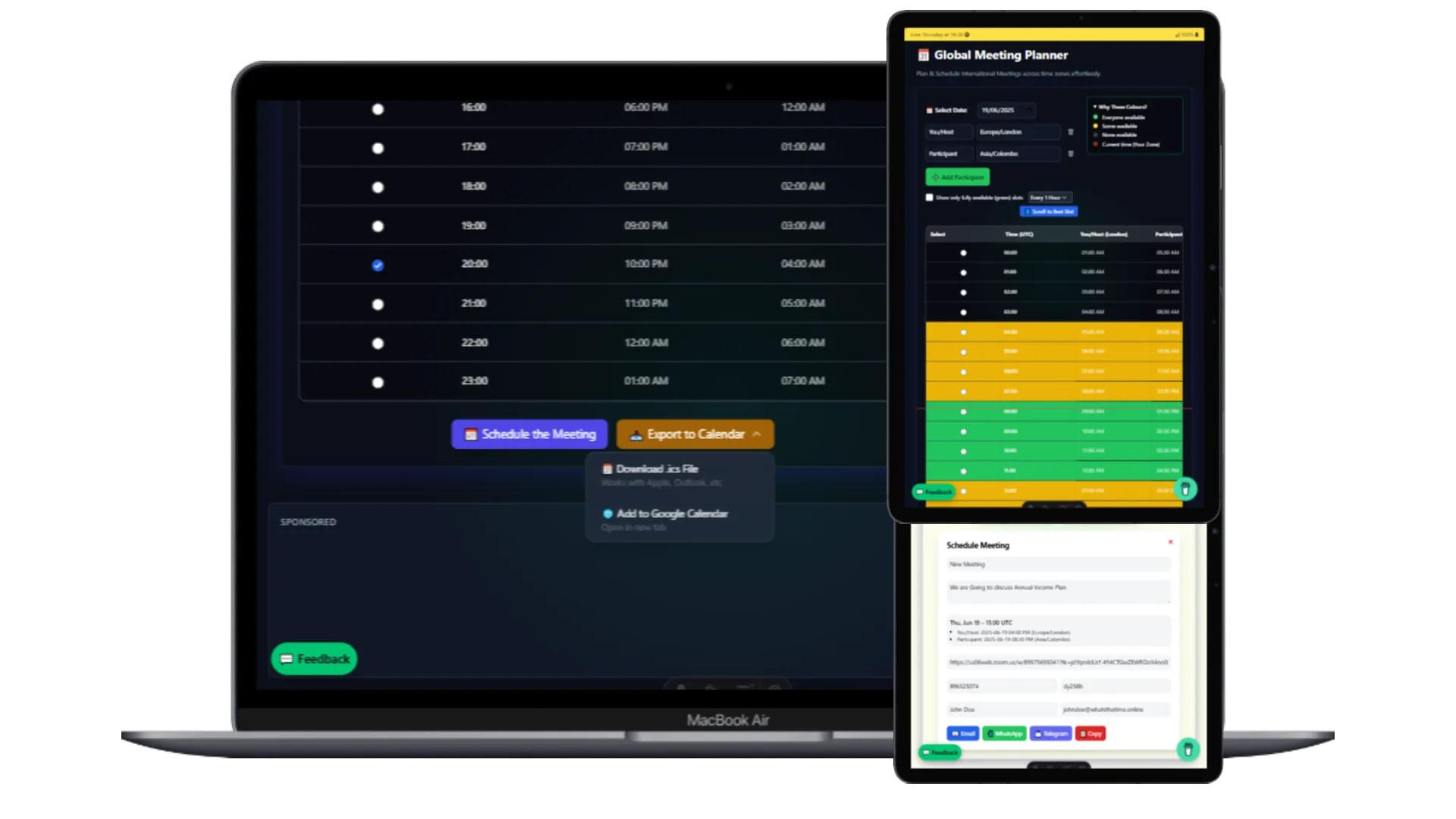Top 10 Meeting Planners for Scheduling Across Time Zones in 2025 🌍🕒
Planning meetings across time zones can be a nightmare 🌐⏰ — until you find the right tool. In this guide, we compare 10 of the best meeting planners that make global scheduling painless. Whether you’re a remote team, digital nomad, or event organizer, these tools help you align across continents.
1. 🌟 Global Meeting Planner @WhatstheTime
Meetings that match everyone’s sleep and work hours.
The Global Meeting Planner by WhatsTheTime is built to make timezone chaos a thing of the past. With a stunning glassmorphic UI, real-time slot suggestions, and intelligent availability highlighting — it’s a modern alternative to the boring spreadsheet method.

🌐 Key Features
- Live, color-coded time slot grid with availability
- Auto-detect participant zones (with alias support)
- iCal + Google Calendar exports
- Shareable links, popups, emoji labels (sleep/work/weekend)
- Designed for elegance + usability
✅ Pros
- Sleek UI, mobile-friendly
- Easy to use for groups, no sign-in required
- Time zone conversion, notes, and copy/share built-in
❌ Cons
- Newer tool; still expanding feature set
- No recurring meetings (yet)
⚡ Try it Live :)
2. Calendly
The classic scheduling tool for professionals.
Calendly is a well-known and widely adopted tool to schedule meetings, especially for 1-on-1s and sales demos.
✅ Pros
- Auto timezone adjustment
- Zoom/Meet integrations
- Great calendar sync + availability management
❌ Cons
- Free plan is limited
- Pricing grows fast for teams
3. Doodle
Poll-based scheduler for groups.
Doodle lets invitees vote on time slots. Works well for community events or cross-timezone groups with no fixed calendar.
✅ Pros
- Poll style, timezone auto-adjusted
- Easy for invitees
❌ Cons
- Requires organizer action after votes
- No calendar sync
4. Zencal
Aesthetic and minimalist Calendly alternative.
Zencal is growing in popularity thanks to its clean design and useful integrations.
✅ Pros
- Payment support
- Custom branding
- Clean interface
❌ Cons
- Limited on free plan
- Fewer integrations than Calendly
5. World Time Buddy
Time zone comparison tool, not a booking system.
WTB offers an intuitive drag-and-compare grid to find overlaps.
✅ Pros
- Clear timezone grid
- Fast and responsive
❌ Cons
- No calendar booking or sharing
- Not ideal for large group planning
6. Google Calendar Appointment Slots
Built-in option for Google Workspace users.
Appointment slots in Google Calendar support timezone syncing and simple availability.
✅ Pros
- No extra tools if you’re in Google Workspace
- Integrates Meet
❌ Cons
- No public page or availability grid
- Lacks slot suggestions or polls
7. OnceHub (ScheduleOnce)
Robust scheduler for sales and customer teams.
ScheduleOnce is a powerful enterprise tool for structured bookings.
✅ Pros
- Team routing
- Powerful rules engine
❌ Cons
- Complex to set up
- UI is dated
8. Reclaim.ai
AI calendar co-pilot for busy professionals.
Automatically blocks time for focus, breaks, meetings — based on behavior.
✅ Pros
- Smart scheduling
- Adjusts dynamically
❌ Cons
- Not for external bookings
- Somewhat confusing for non-tech users
9. Clockwise
Optimize team calendars to reduce fragmentation.
Clockwise auto-moves events to create focus time.
✅ Pros
- Ideal for internal teams
- Works with Slack and Google
❌ Cons
- No direct scheduling link
- Focused on internal productivity
10. Rallly
Open-source poll-based scheduler.
Free, privacy-friendly, and collaborative — great for small groups.
✅ Pros
- Fully free
- Community-driven
❌ Cons
- No integration or export features
- Basic UI/UX
🔚 Final Thoughts
Each planner has its niche — but if you’re looking for something visually modern, powerful, and truly made for 2025 remote teams, our Global Meeting Planner is the ultimate choice.
✅ Try it live, free, and beautifully embedded above.
This post is accurate as of June 2025. Let us know if you’d like to see comparison tables or interactive previews next!